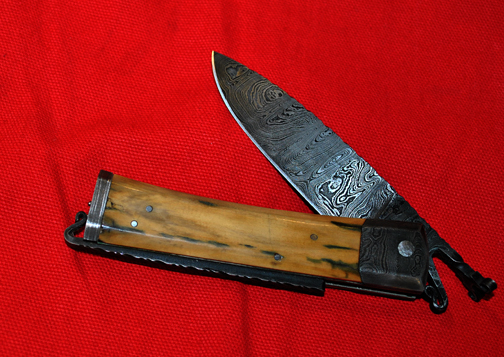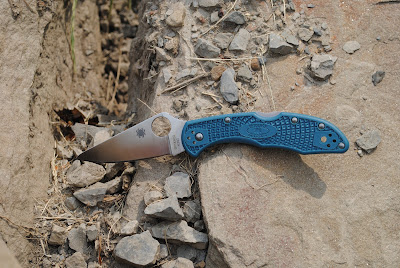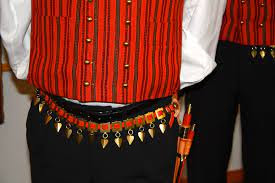The problem
with sales, of course, is the customers.
They ask such
questions, act so aggravating and in general, can be a real pain in the tuchus. But to a large degree, they are
untouchables. You clench your jaws
together, bite your lips, force a smile and generally restrain from violence.
I have
nothing but respect for people employed in the service industry because they
have to deal with jerks like me.
One fellow after
inspecting several knives kept coming back to the same folder. “I’ll take this,” and he pulls out a wallet
and hands me a dollar. I want to say “There isn’t a knife at this show you can buy for a dollar. Not even at the 3 for $5 knife buckets, not
even at the TSA guy who is selling junk knives confiscated by TSA and sold to
vendors in 100-pound lots.”
“I need a
99 more dollars, sir.” He doesn’t have
to know SIR stands for Simpering Imbecile Retard.
Realizing
he had misread the price, he said, “Oh, I thought it was a dollar.” I want to ask him how much he paid for gas
last week or if he has bought a dozen eggs in the last 6 months. How could he
think a knife could sell for a dollar?
But I don’t.
He looks embarrassed
and I sputter for a second before I come back with, “I’m afraid not, sir
(See! There’s that word again.)
Later
another guy walks up and asks, “Do you buy knives?”
The answer
is the first rule of improv comedy, “Yes, I do.” I modify that with “Sometimes.
What do you have?”
That’s the setup and here comes the spike, “I really would like to trade knives. I have a switchblade and I’m looking for
something else.” Oh!
The switchblade
is a POS with a secondary seatbelt cutter built into the handle. The poorly made knife is of Chinese
origin. Having it on my table would make a mockery of the expensive, well made Chinese knives I carry. You might get 25 bucks,
including tax and shipping for it, retail.
The least expensive auto I have is $53.
“I don’t
think it’s right for me.”
“I have two
of them.”
I want to
tell him, that’s not a positive negotiating point. I want to tell him even if we tossed in the
price of the knife he wanted, I’d be stuck with a POS I can’t sell. “Thanks, but no thanks!”
Understand,
you have to be nice. They may come back later
with a more collectable knife in the future, perhaps we can do business later.
Later I’m presented
with an old, worn, dirty, over-sharpened Case knife, and told it had to be over
a hundred years old, because it belonged to his 90-year-old grandfather.
I don’t ask
if the birth was difficult as the baby was born with a 10-year-old knife in its
hand. It also raises some interesting
ideas about Mom’s everyday carry.
He pauses
and seems to be waiting for me to make an offer. “It must have great sentimental value to
you.” Which is code for put that back in
your pocket and unless you are shopping, get away from my table!
I don’t
bother telling him and others that old is not the same as valuable.
I enjoy
talking to knife collectors and fanciers but don’t bother me with your tales
of why you don’t need one because you have a two-bladed knife you bought in the 60s and have proceeded over the last half century to sharpen the life out of
the blade. You think you’re clever,
making do with it until you sharpen the last atom of iron off the blade.
I want to
let you know you’re making a wise choice in keeping that knife because the
current knives are too much and far beyond your abilities. I don’t.
Midway through
the show, I get an offer of 70 bucks for a $120 knife. I politely decline and countered with
$110. He walks away. I’m very cool with that. Knife shows aren’t quite a store and a little
bargaining can be expected. But I’m not a flea market either.
He returns
a couple of hours later and reexamines the knives.
“You said
70 on this,” he says.
I laugh and
say “No sir.” Here is where I screw
up. I continue with “I said $110.”
He said,
“Well, I thought you might have forgotten.”
I should
have said “I said $135.” And if he
objected, pointing to the marked price and his memory of our discussion, add
“There’s an increase for failing to bargain in good faith.” But I didn’t.
But sometimes
the interactions make it all worthwhile.
An older woman comes up and is interested in the SpyderCard on my table. I tell her they are hard to find and she agrees
and pulls one out of her pocket!
Then she shows
me her favorite knife, a very nice CRKT long since discontinued. She carries it wrapped in a clean
handkerchief to protect it.
I show her
the protective sleeve I buy to protect some of my knives in transit, but I
can’t sell her one because I don’t have any pricing or even the name of the
product, just the sleeve. We successfully
negotiate the price on the Spydercard. I
make a little less money, but turn product into cash. She spends a little less and gets a knife she
really wants. I like talking with her so
much, I throw in a siliconized knife sleeve to protect her favorite knife.
I had a
very good time.
 |
| Where is my missing finger? |
During the
entire show, my wife keeps asking me if I’m alright. I’m always a little nervous about shows. We bought all those knives. Did I buy the right ones? Did I make good trades? Am I reading the market right?
Finally,
after being asked over and over if I’m alright, I look down at my hand and start to
jump up.
“Oh! My
GOD! I only have four fingers!” I point to the hand with only four fingers.
Now she’s
agitated.
“Only
four.” My voice gets a little louder and
more excited. “I’m missing a finger. What happened to it!” She is beginning to get alarmed, not thinking
everything through, after all we handle a lot of sharp edges.
I turn my
hand over to show my thumb tucked under my palm.
“Oh! There it is.”
For all my
acting and improv skills I get “Oh, you
goofball.”
Yeah, it’s
the interactions that make it interesting.






























